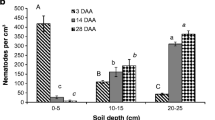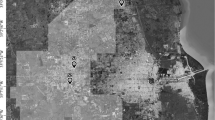Abstract
The life cycle of the Antarctic Dry Valley soil nematode, Scottnema lindsayae (Timm 1971) was studied in laboratory culture at two temperatures, 10°C and 15°C. Soil yeast and bacteria isolated with the nematodes were used as the food source. The species reproduced sexually. The higher temperature had a negative effect on the life cycle. The number of eggs per female and the number of juveniles developing per female were greater at 10°C than at 15°C. Juveniles developed faster at 10°C and four juvenile stages were observed outside of the egg at both temperatures. The unusually long life cycle (218 d at 10°C) suggests that more than one austral summer may be required for successful completion. An increase in Dry Valley soil temperatures associated with potential global environmental change may have detrimental effects on soil nematodes.
Similar content being viewed by others
References
Anderson RV, Coleman DC (1981) Population development and interaction between two species of bacteriophagic nematodes. Nematologica 27:6–19
Andrássy I (1956) Die Rauminhalts- und Gewichtsbestimmung der Fadenwürmer (Nematoden). Acta Zool Acad Seien Hung 2:1–15
Andrássy I (1985) A dozen new nematode species from Hungary. Opusc Zool Budapest 19/20:3–39
Atlas RM, Di Menna ME, Cameron RE (1978) Ecological “investigations of yeasts in Antarctic soils. Antarct Res Ser Wash 30:27–34
Banage WB (1963) The ecological importance of free-living nematodes with special reference to those of Moorland soil. J Anim Ecol 32:133–140
Claridge GGC, Campbell IB (1968) Soils of the Shackelton Glacier region, Queen Maud Range, Antarctica. NZJ Sci 11:171–218
Freckman DW, Baldwin JG (1990) Nematoda. In: Dindal DL (ed) Soil Biology Guide. John Wiley and Sons, New York, pp 155–200
Freckman DW, Virginia RA (1990) Nematode ecology of McMurdo Dry Valley ecosystems. Antarctic J US 25:229–230
Freckman DW, Virginia RA (1992) Nematodes in the Dry Valleys of Southern Victoria Land. Antarctic J US
Heyns J (1969) South African species of the genus Acrobeles von Linstow (Nematoda: Cephalobidae). Phytophylactica 1:57–66
Jenkins WR (1964) A rapid centrifugal flotation technique for extracting nematodes from soil. Plant Dis Rep 48:692
Johnson SR, Ferris JM, Ferris VR (1974) Nematode community structure of forest woodlots: III. Ordinations of taxonomic groups and biomass. J Nematol 6:118–126
Marinari-Palmisano A, Turchetti T (1976) Sviluppo delle popolazioni di una specie di Cephalobus (Nematoda: Cephalobidae) in associazione con batteri diversi. Redia G Zool 59:155–169
Maslen NR (1979) Additions to the nematode fauna of the Antarctic region with keys to taxa. Br Antarct Surv Bull 49:207–229
Maslen NR (1981) The Signy Island terrestrial reference sites: XII. Population ecology of nematodes with additions to the fauna. Br Antarct Surv Bull 53:57–75
Pickup J (1990) Seasonal variation in the cold-hardiness of a freeliving predatory Antarctic nematode, Coomansus gerlachei (Mononchidae). Polar Biol 10:307–315
Sohlenius B (1973a) Growth and reproduction of a nematode Acrobeloides sp. cultivated on agar. Oikos 24:64–72
Sohlenius B (1973b) Influence of food supply on population structure and length distribution in Acrobeloides nanus (Nematoda: Cephalobidae). Pedobiologia 13:205–213
Spaull VW (1973) Qualitative and quantitative distribution of soil nematodes of Signy Island, South Orkney Islands. Br Antarct Surv Bull 33/34:177–184
Steiner G (1929) On the gross morphologie of Acrobeles (Acrobeles) crossotus n. sp. (Rhabditidae, Nematoda) found in diseased bulbs of Iris tingitana Boiss. and Reut, with remarks on its ecology and life cycle. Z Morph Ökol Tiere 15:547–558
Tahseen Q, Jairajpuri MS, Ahmad I (1991) Observations on the embryonic and post-embryonic development of Diploscapter orientalis (Nematoda: Rhabditidae). Revue Nématol 14:251–260
Thomas PR (1965) Biology of Acrobeles complexus Thorne, cultivated on agar. Nematologica 11:395–408
Thorne G (1925) The genus Acrobeles von Linstow, 1877. Trans Am Microsc Soc 44:171–210
Timm RW (1971) Antarctic soil and freshwater nematodes from the McMurdo Sound region. Proc Helminth Soc Wash 38:42–52
Vincent WF (1988) Microbial ecosystems of Antarctica. Cambridge Univ Press, New York
Wharton DA, Brown IM (1989) A survey of terrestrial nematodes from the McMurdo Sound region, Antarctica. NZJ Zool 16:467–470
Yeates GW (1967) Studies on nematodes from dune sands. 5. Acrobelinae. NZJ Sci 10:527–547
Yeates GW (1970) Studies on laboratory cultures of dune sand nematodes. J Nat Hist 4:119–136
Zuckerman BM (1987) Nematodes as models to study biological aging. In: Veech JA and Dickson DW (eds) Vistas on Nematology. Society of Nematologists, Hyattsville, Maryland, pp 414–123
Author information
Authors and Affiliations
Rights and permissions
About this article
Cite this article
Overhoff, A., Freckman, D.W. & Virginia, R.A. Life cycle of the microbivorous Antarctic Dry Valley nematode Scottnema lindsayae (Timm 1971). Polar Biol 13, 151–156 (1993). https://doi.org/10.1007/BF00238924
Received:
Accepted:
Issue Date:
DOI: https://doi.org/10.1007/BF00238924




